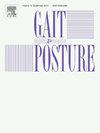Influence of curve location and type of adolescent idiopathic scoliosis on static and dynamic plantar pressure
IF 2.2
3区 医学
Q3 NEUROSCIENCES
引用次数: 0
Abstract
Objective
This study aimed to investigate the characteristics of various plantar pressure parameters of patients with different curve locations (thoracic/lumbar) and types (single/double) of adolescent idiopathic scoliosis (AIS).
Methods
Seventy-eight moderate AIS patients were included from Nanjing Drum Tower hospital, who were then classified into 4 groups by curve location and type, single thoracic scoliosis (S-T, n = 20), single lumbar scoliosis (S-L, n = 16), double curves with major curve at thoracic region (D-T, n = 22), double curves with major curve at lumbar region (D-L, n = 20). Another 22 healthy subjects were included as the control group. Multiple static and dynamic features, such as medial-lateral (M-L) area ratio and loading pattern were compared across groups.
Results
For static plantar pressure, on the major curve side, the medial-lateral (M-L) area ratio was significantly different among five groups on both feet (P < 0.01). The ratio of S-T group was significantly lower than lumbar scoliosis groups on major curve side (P < 0.01). In midfoot, ratios of thoracic scoliosis groups were significantly lower than S-L group P < 0.01). On the compensatory side, D-L group had markedly lower ratio than thoracic groups in M-L area ratio and midfoot M-L area ratio (P < 0.01). For dynamic plantar pressure, the maximum pressure of medial rearfoot of thoracic scoliosis was significantly lower than lumbar scoliosis and control group on major curve side(P < 0.01). Meanwhile, the lateral rearfoot of thoracic had greater pressure than lumbar scoliosis groups (P < 0.01). The load distribution of metatarsal head (MH) had marked differences among groups on the compensated side, especially at MH1, MH4 and MH5 P < 0.01). Moreover, the loads of thoracic scoliosis were significantly larger than lumbar scoliosis at MH5 (P < 0.01).
Conclusion
In moderate AIS patients, scoliosis curve location significantly affected static and dynamic plantar pressure while single or double curves had limited impact.
求助全文
约1分钟内获得全文
求助全文
来源期刊

Gait & posture
医学-神经科学
CiteScore
4.70
自引率
12.50%
发文量
616
审稿时长
6 months
期刊介绍:
Gait & Posture is a vehicle for the publication of up-to-date basic and clinical research on all aspects of locomotion and balance.
The topics covered include: Techniques for the measurement of gait and posture, and the standardization of results presentation; Studies of normal and pathological gait; Treatment of gait and postural abnormalities; Biomechanical and theoretical approaches to gait and posture; Mathematical models of joint and muscle mechanics; Neurological and musculoskeletal function in gait and posture; The evolution of upright posture and bipedal locomotion; Adaptations of carrying loads, walking on uneven surfaces, climbing stairs etc; spinal biomechanics only if they are directly related to gait and/or posture and are of general interest to our readers; The effect of aging and development on gait and posture; Psychological and cultural aspects of gait; Patient education.
 求助内容:
求助内容: 应助结果提醒方式:
应助结果提醒方式:


